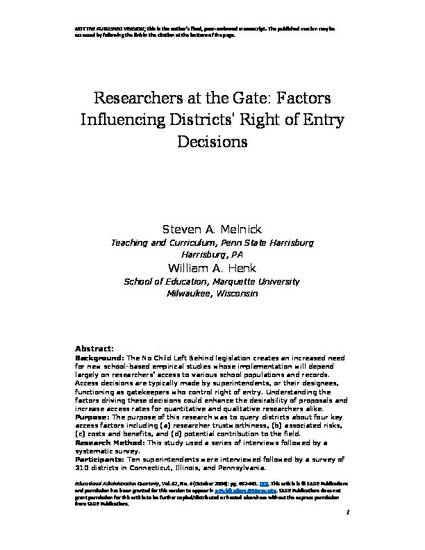
Background: The No Child Left Behind legislation creates an increased need for new school-based empirical studies whose implementation will depend largely on researchers’ access to various school populations and records. Access decisions are typically made by superintendents, or their designees, functioning as gatekeepers who control right of entry. Understanding the factors driving these decisions could enhance the desirability of proposals and increase access rates for quantitative and qualitative researchers alike.
Purpose: The purpose of this research was to query districts about four key access factors including (a) researcher trustworthiness, (b) associated risks, (c) costs and benefits, and (d) potential contribution to the field.
Research Method: This study used a series of interviews followed by a systematic survey.
Participants: Ten superintendents were interviewed followed by a survey of 310 districts in Connecticut, Illinois, and Pennsylvania.
Findings: Although trustworthiness was expected to supercede other factors, districts reported greater interest in elements of risk and in research having widespread educational value. Costs and material benefits (e.g., equipment, credit, and compensation) were not highly emphasized nor relatively important. Professional development, planning, and instructional benefits mattered more.
Implications for Research and Practice: Given the increasing emphasis on scientifically based research for school decision-making and program reform, the present study is notable for two reasons. First, it provides researchers with insights into the decision-making process involved in granting permission to conduct research in the schools. Second, it can help to improve the quality of proposals received by school districts, thereby increasing the likelihood of positive right-of-entry decisions and resulting in better informed decisions.
Available at: http://works.bepress.com/william_henk/15/

Accepted version. Educational Administration Quarterly, Vol. 42, No. 4 (October 2006): 652-661. DOI. © 2006 SAGE Publications. Used with permission.